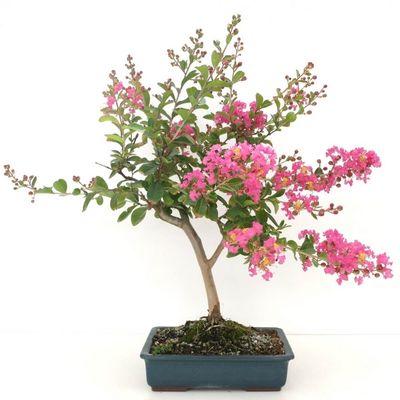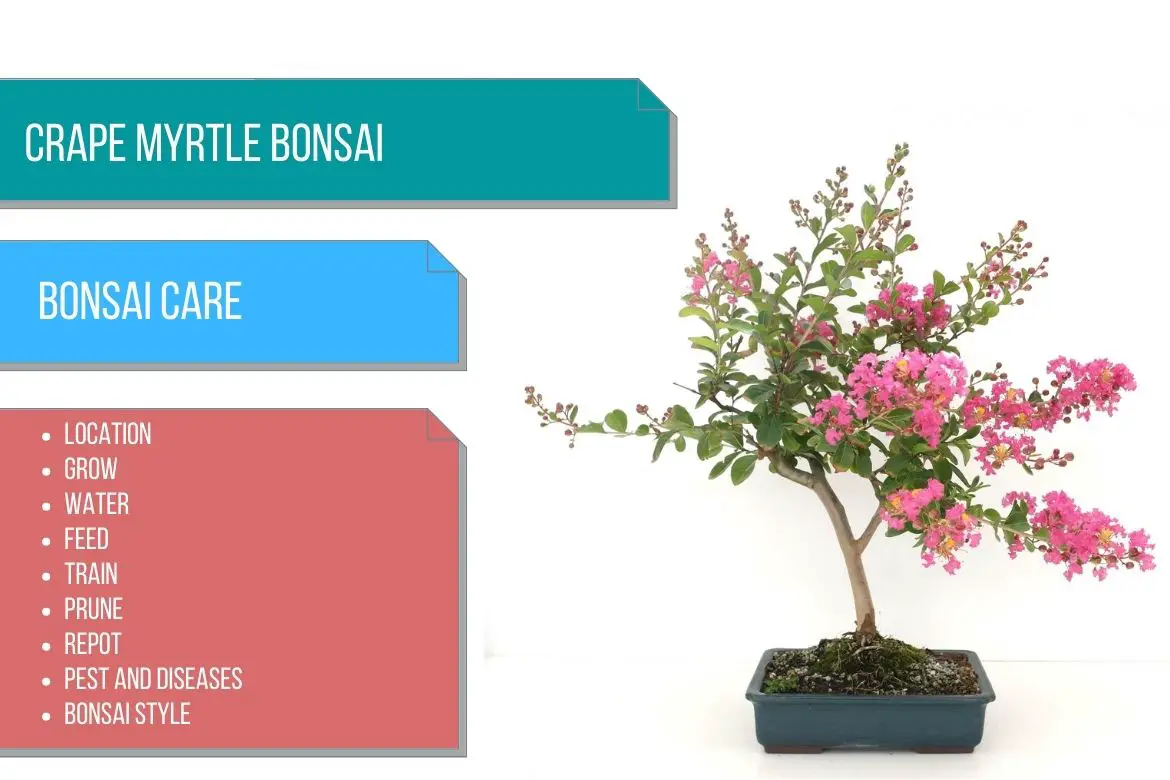
Crepe Myrtle
(Lagerstroemia Indica)
Country of Origin : China and Korea
Bonsai Styles : Informal upright, slanting, semi-cascade, root-over-rock
Zone : 7 – 10

The Crepe myrtle is a deciduous, subtropical treelike shrub.
Crepe myrtle plants are grown for their short-lived but spectacular display of flowers that can range in color from deep purples to pinks to almost white.
However, for bonsai enthusiasts, the Crepe myrtle bonsai tree not only provides the attraction of the flowers but also a stunning bark structure.
Bark peels off in irregular flakes as it ages, revealing a different colored underside. Depending on the time of year, the color of the under-bark can range from pale grey to brown and almost pink.
This produces an extremely attractive patchwork of subtle colors, which is particularly impressive in the autumn and winter when the leaves are shed and the bark is more visible.
Crape myrtle is one of the few deciduous shrubs that can be grown indoors. In order for its flowers to develop in their full beauty, it needs lots of warmth and sunlight in the summer.
Best location to keep Crepe Myrtle Bonsai
During summer, this can be grown outdoors in temperate climates. It can be kept near an open window or on a balcony or windowsill outside.
The plant can tolerate sun exposure through glass. Crepe Myrtle bonsai tree can survive in a temperature range of 45 to 100 °F (7 to 37°C)
Acclimatize by gradually increasing the length of time spent outside each day if leaving outside at night. On the first night, make sure the night is not too cold.
To allow leaf drop and dormancy in winter, keep the tree cool but frost-free. To induce dormancy, lower the light level and the temperature.
A lack of dormancy will cause premature spring growth, weaken the tree, and reduce its flowering period.
Low light levels combined with warm weather results in sappy, elongated growth, so maintain cool conditions through the winter and early spring when the day length is short.
45 to 50 °F (7 to 10°C) temperature range in winter is advisable.
Refer sunlight requirements for indoor plants for more indoor gardening ideas. Also, refer to do bonsai trees need sunlight for more indoor and outdoor bonsai location ideas.
Propagation of Crepe Myrtle
Crepe Myrtle tree can be propagated by sowing seeds in spring.
Softwood cuttings can be used to propagate the tree in summer.
Watering Crepe Myrtle Bonsai
These trees are pretty drought tolerant. Hence they are little forgiving when it comes to watering.
During the growing season, make sure the tree receives plenty of water and water sparingly when it is dormant. However, don’t let the bonsai soil completely dry out. Check it regularly.
During spring, the buds will swell, signaling it is time to increase the water gradually.
Wiring Crepe Myrtle Bonsai
Crape myrtle bonsai tree responds well to wiring. After pruning, wire the young shoots and let them grow a little before cutting them back.
Try and bend the shoots and fill the empty spaces in the tree. However, don’t fight the natural growing direction too much.
Pruning Crepe Myrtle Bonsai
When to prune Crepe Myrtle bonsai?
How to prune Crepe Myrtle bonsai?
Pruning can be done in the fall to achieve or maintain the desired bonsai style. Hollow out pruning wounds to prevent swelling during the healing process.
Let the spring growth continue until the leaves begin to harden. Then cut all shoots back to two or three leaves.
In late summer/autumn, the next crop of shoots will produce flowers, so don’t prune the shoots before you know exactly where the buds will develop.
Pinching Crepe Myrtle Bonsai
In order to grow flowers, avoid pinching out any growth until late summer. Because at this time the flower buds will be visible and you will not accidentally remove any potential flower bearing shoot.
Keep the tree neat by pinching only overextended shoots.
Repotting Crepe Myrtle Bonsai
When to repot Crepe Myrtle bonsai?
Crepe Myrtle Bonsai tree can be repotted every year or 3 years, depending on the size of the tree.
Mid spring is a good time to repot the plant.
You can use a basic bonsai soil mix as a potting soil.
OR
You can also use a soil mix consisting of 40% grit and 60% organic matter.
Must Read: Bonsai Soil Recipes
Must read : Choosing the right bonsai container
Feeding Crepe Myrtle Bonsai
To keep vigor under control and maximize flowering, apply regular low-nitrogen feeds during the growing season and one or two nitrogen-free feeds in the fall.
Read more about bonsai fertilizer and its application.
Diseases and pest of Crepe Myrtle Bonsai
Generally, these trees are pest-free, but aphids and mildew can be problematic if the tree is neglected.
Crepe Myrtle bonsai care
Due to this species’ deciduous nature, you need to keep it pretty cool, but not frosty, in winter to ensure a sufficient dormant period. In the absence of this, the tree would eventually become exhausted and die.
Temperatures should be kept between 45 and 50°F during winter. Allow light levels to fall (in winter) as the leaves fall from the trees.
As soon as buds start swelling in spring, restore good light.
Unless you are willing to miss the flowering period for a year, do not prune away lateral growth in midsummer.
By reducing the nitrogen content of the fertilizer, you can further encourage flowering. A tomato or rose fertilizer would be ideal for this purpose. Refer to flowering bonsai feeding schedule fore more details.
Exposure to the sun and regular spraying with fresh water will encourage the bark to flake.
What to look for when buying Crepe Myrtle Bonsai
Don’t buy trees still in leaf if you’re buying your Crepe myrtle bonsai in late fall or winter. It is highly likely that it won’t work well.
You should look for bonsai with a thick trunk line that is attractive. More under-bark can be appreciated when the trunk is thicker.

